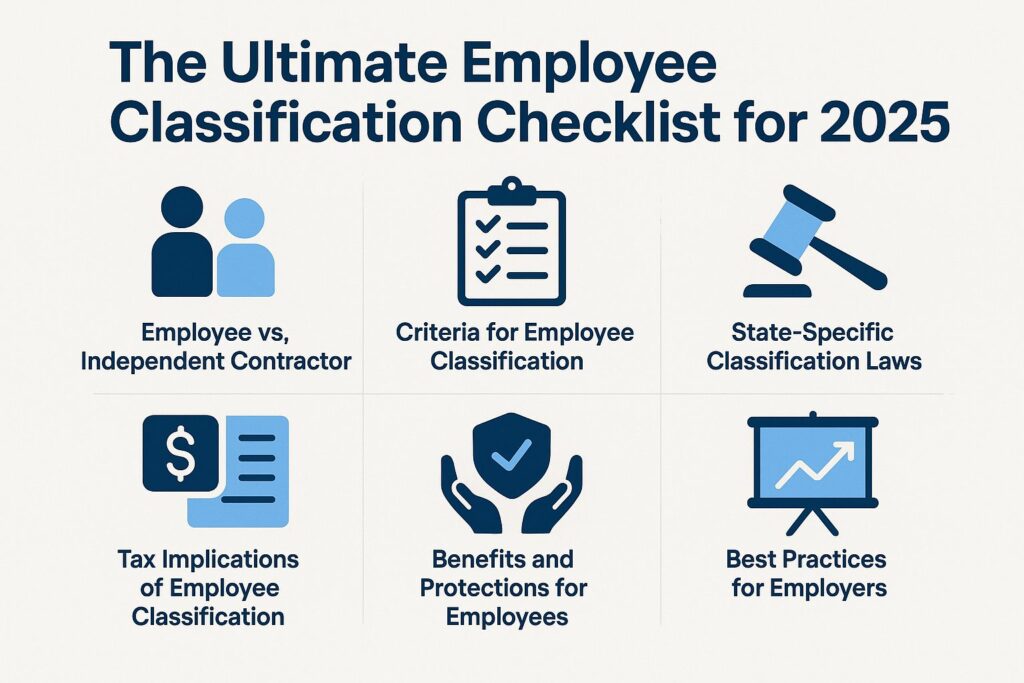
The Ultimate Employee Classification Checklist for 2025
Are you confident in your employee classification practices? As rules become stricter and workers change, it is very important to do things correctly now. Knowing how employees differ from independent contractors can help you avoid expensive errors. This checklist includes the necessary rules for classification, laws specific to each state, tax effects, and recommended practices to meet legal requirements. Learn how to protect your business and help your employees in practical ways.
Importance of Proper Employee Classification for Workforce Management
Proper employee classification and compliance prevent costly legal issues, with misclassifications potentially leading to fines exceeding $1 million in cases like Uber’s contractor misclassification.
Specific penalties often arise from misclassifying employees as independent contractors, which can leave companies liable for unpaid taxes and benefits. For example, the IRS imposed $3 million in back taxes on FedEx for misclassifying drivers as independent contractors.
To avoid these pitfalls, businesses should classify employees based on their level of control and dependency on the employer. Using tools like Intuit’s QuickBooks for managing payroll or getting advice from lawyers can help classify workers correctly and prevent possible problems later on. Worth exploring: 5 Common Payroll Mistakes to Avoid with Outsourcing.
Overview of Employee Classification Types and Classification Systems
Employee classification typically encompasses full-time employees, part-time employees, independent contractors, and freelancers, each defined by distinct job responsibilities, classification criteria, and legal considerations.
Full-time employees usually work 30-40 hours per week and receive benefits like health insurance and paid leave. Part-time employees often clock fewer hours and may not receive similar benefits.
Contractors operate under a set contract and typically manage their own taxes and insurance, while freelancers work independently, offering services to multiple clients without long-term commitments.
Knowing these categories is important for following labor laws and handling payroll properly, making sure each job is paid fairly and legally.
Understanding Employee vs. Independent Contractor and Worker Classification Systems
Knowing the difference between employees and independent contractors is essential because different rules apply to them, which impacts taxes and eligibility for benefits.
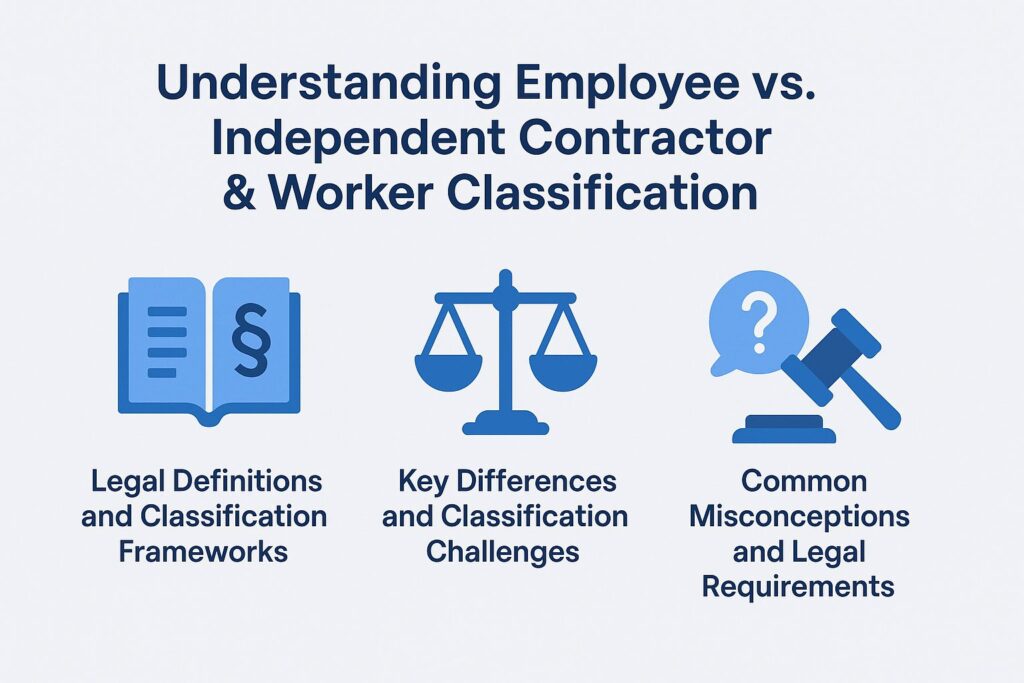
Legal Terms and Categories
The IRS says an employee is a person who works under the employer’s direction, while independent contractors work on their own and make their own choices.
For example, if a graphic designer is hired by a company to create specific marketing materials and follows strict guidelines on style and deadlines, they are likely classified as an employee.
Conversely, a freelance writer who sets their own hours and determines the topics they cover for various clients typically falls under the contractor category.
To avoid misclassification pitfalls, employers should refer to IRS guidelines, assessing the degree of control exercised over the work and examining payment structures.
Using tools like QuickBooks can make contractor payments easier and help with correct reporting.
Key Differences and Classification Challenges
Key differences between employees and independent contractors include control over work, payment structure, and entitlements to benefits such as health insurance classifications.
Employees typically have their work closely supervised, with set hours and specific job descriptions, enjoying benefits like paid vacation and insurance coverage.
In contrast, contractors operate autonomously, setting their own hours and choosing their projects, but they generally lack benefits.
Financially, employees receive regular salary payments with taxes withheld, while contractors invoice for work completed, managing their own tax obligations.
Recognizing these differences is important for both sides to follow labor laws and match expectations.
Common Misconceptions and Legal Requirements
Common misconceptions about employee classification, such as assuming freelancers have no rights or that all part-time workers are contractors, can lead to significant compliance risks.
For example, freelancers are often entitled to certain protections under labor laws, depending on the jurisdiction.
According to a 2021 study, misclassifying employees can result in penalties ranging from $1,000 to $10,000 per violation.
Knowing that part-time workers might be eligible for the same benefits as full-time employees can help avoid expensive disagreements.
It’s important to check resources like the IRS guidelines or use tools like the DOL’s Worker Classification Tool to correctly categorize workers and reduce legal problems.
Criteria for Employee Classification and Classification Audits
Employee classification depends on how much control the employer has over the worker’s behavior, the financial aspects of the work, and the nature of their relationship.

Behavioral Control and Performance Evaluations
Behavioral control is about how much an employer decides on the details of work tasks, such as the methods, timing, and location, which greatly affects how a job is classified within organizational structures.
For instance, an employer who specifies work hours and monitors employee tasks closely may classify workers as employees rather than independent contractors.
Conversely, if workers have flexibility in their schedules and autonomy in task execution, they are more likely to be classified as independent contractors. This can lead to significant legal and financial implications.
Tools like time-tracking software, used to impose strict work schedules, often push workers into employee classifications. Knowing how to handle and manage behavior can directly influence how a worker is classified.
Financial Control and Payroll Implications
Financial control pertains to how an employee or independent contractor is compensated, impacting their classification due to variations in risk, payroll implications, and investment responsibilities.
For instance, employees usually receive a consistent salary, enjoying benefits like health insurance and retirement plans.
In contrast, contractors invoice for services rendered and cover their own expenses, leading to greater financial risk. This difference in payment structure emphasizes how employees have less control over their financial outcomes compared to contractors, who must manage their own taxes and health insurance.
Knowing these differences is key for businesses to avoid mistakes that could lead to legal trouble and fines.
Relationship of the Parties and Employment Status
The type of connection between a worker and their employer, such as benefits provided and job security, is important for deciding job classification.
Factors influencing this classification include the presence of written contracts, which can clarify expectations and responsibilities for both parties. For instance, a formal contract often stipulates benefits eligibility, outlining healthcare and retirement plans based on the worker’s status-either independent contractor or employee.
The length of the relationship is significant; longer engagements may lean toward employee classification due to perceived permanence. Checking these parts helps organizations follow labor laws and avoid fines for incorrect classification.
Legal Rules for Classification Vary by State
Employee classification laws differ a lot between states, with some states having rules that are stricter than the federal ones. Understanding these variances can be crucial for businesses considering payroll services. Curious about how payroll outsourcing works? This insight might help in navigating the complexities of state-specific regulations.
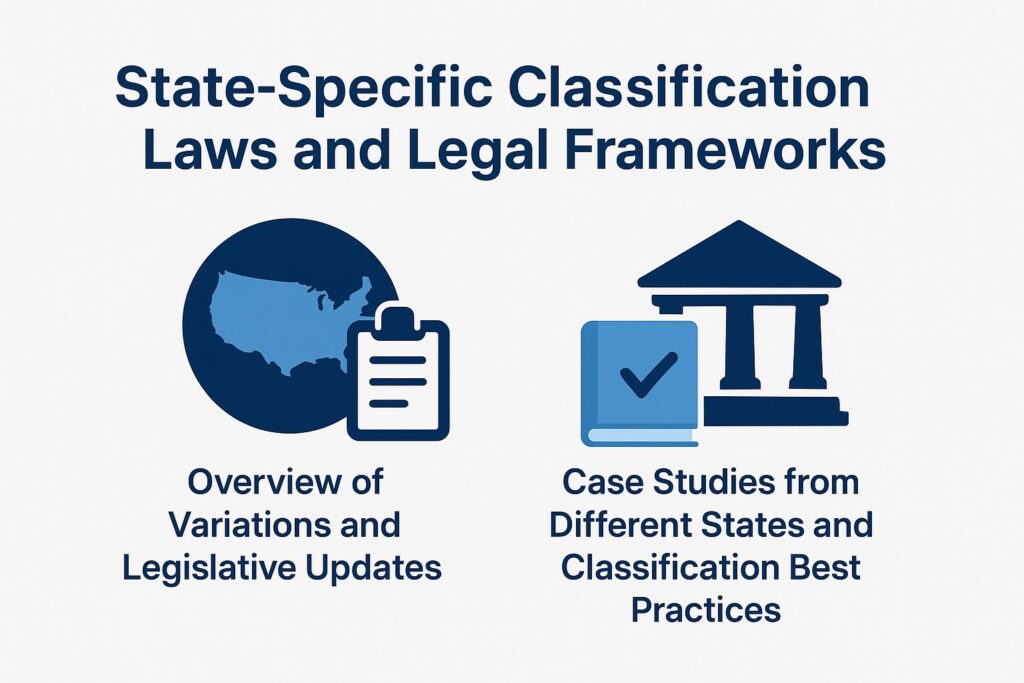
Overview of Variations and Legislative Updates
States like California impose the ABC test for independent contractors, while others adhere to the common law test, creating challenges for national employers.
For instance, New York employs a more flexible standard known as the `Economic Realities Test,’ which considers various factors like control and opportunity for profit. Meanwhile, Texas typically follows the common law test but favors simplifying contractor classifications.
Employers must stay informed about these distinctions, as misclassification can lead to hefty penalties. Tools like Gusto or Zenefits help manage legal requirements in various states, making sure your business follows all regulations and lowers risks.
Case Studies from Different States and Classification Best Practices
Analyzing case studies from different states reveals how misclassification incidents have shaped local laws and employer practices.
For example, in California, the landmark Dynamex decision tightened the criteria for classifying workers as independent contractors, leading many companies to reassess their workforce structure.
On the other hand, a major decision in Texas confirmed that delivery service workers are classified as contractors, supporting the current system.
These developments show how misclassification can lead to expensive lawsuits and changes in regulations. Employers need to use clearer contracts and better documentation practices.
In the end, businesses need to stay updated and flexible to handle these changing laws well.
Tax Implications of Employee Classification and Risk Management
How workers are classified is important for taxes, impacting payroll taxes for employees and self-employment taxes for independent contractors. For those curious about managing these complexities, our comprehensive study on the benefits and costs of payroll outsourcing provides valuable insights.
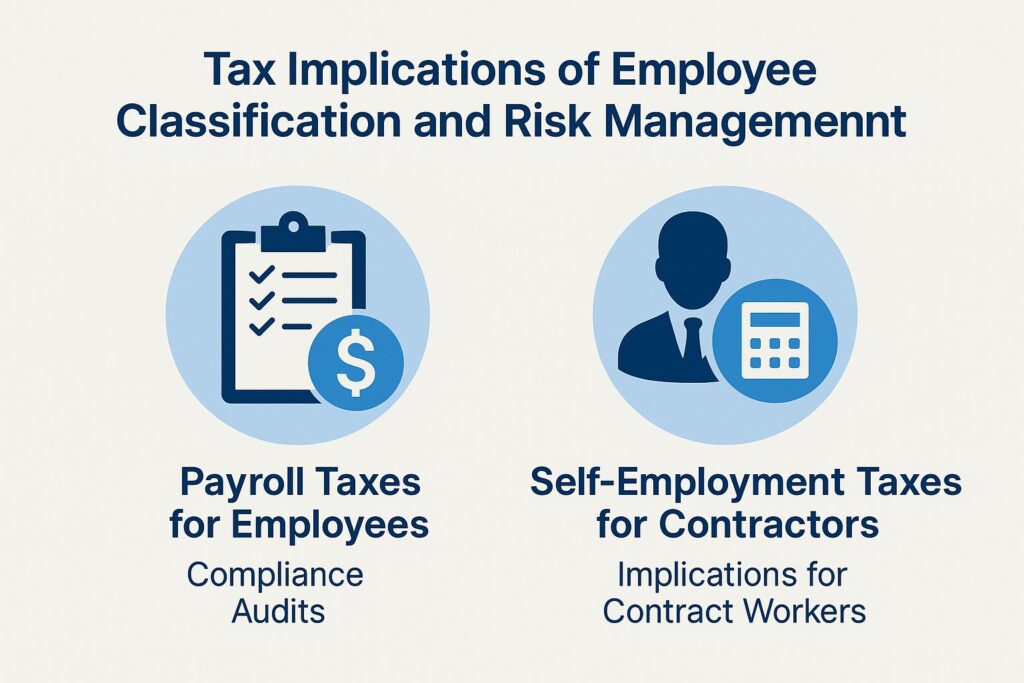
Payroll Taxes for Employees and Compliance Audits
Employees incur payroll taxes including Social Security (6.2%) and Medicare (1.45%), which employers must match, adding to the overall employment cost.
For example, for an employee earning $50,000 annually, the employer is liable for $3,100 in Social Security ($50,000 x 6.2%) and $725 in Medicare ($50,000 x 1.45%), totaling $3,825 solely in payroll taxes.
Employers must consider federal and state unemployment taxes, typically ranging from 0.6% to 6% depending on state regulations. Including these taxes in labor expenses is essential for planning a budget.
An employer might look into tax credits like the Work Opportunity Tax Credit to reduce payroll tax costs.
Self-Employment Taxes for Contractors: Implications for Contract Workers
Independent contractors must pay a self-employment tax of 15.3% for Social Security and Medicare. This tax impacts their earnings, highlighting the need to know labor rules.
Unlike exempt employees, who have taxes automatically withheld from their paychecks, independent contractors must calculate and pay their taxes quarterly, highlighting the differences in employee types.
For instance, if a contractor earns $50,000 in a year, they would owe approximately $7,650 in self-employment taxes, significantly impacting their take-home income and requiring careful financial planning and employee management.
Contractors can deduct business expenses like equipment and home office costs, which can lower their taxable income, helping them adhere to classification guidelines. Knowing these responsibilities is important for good financial planning and knowing employee rights.
Benefits and Protections for Employees: Workforce Diversity and Employee Benefits
Workers get benefits and legal rights, such as health insurance, retirement plans, and safeguards against discrimination, following industry norms and employment agreements.

Health Insurance and Retirement Plans
Employees often receive health insurance coverage and access to retirement plans like 401(k)s, which independent contractors typically must arrange themselves.
Employees often receive health insurance that covers various plans such as HMOs, PPOs, or high-deductible options, with part of the costs usually covered by their employer-an important aspect of employee satisfaction.
In contrast, independent contractors must find their own health insurance through platforms such as Healthcare.gov or private insurance companies, which can be challenging due to differing employee classification categories.
Employees often use 401(k) plans with employer matching contributions for retirement savings. Contractors might need to set up an Individual Retirement Account (IRA) or SEP IRA to make sure they save enough for retirement, illustrating differences in human capital management.
Looking at both choices impacts long-term financial safety and needs knowledge of company rules.
Legal Protections Against Discrimination: Essential Discrimination Laws
Employees are protected under various federal and state laws against discrimination, which do not extend to independent contractors, creating disparities in workplace rights and impacting workforce classification.
Key protections arise from Title VII of the Civil Rights Act, which prohibits employment discrimination based on race, color, religion, sex, or national origin, highlighting the importance of ethical considerations in employment laws.
The Age Discrimination in Employment Act (ADEA) prevents unfair treatment of workers over 40, and the Americans with Disabilities Act (ADA) ensures rights for people with disabilities, showing changes in job market practices.
Each of these laws mandates that employers provide a workplace free from discriminatory practices, ensuring that employees can file complaints with the Equal Employment Opportunity Commission (EEOC) without fear of retaliation, emphasizing employer obligations and internal policies.
Knowing these protections helps employees stand up for their rights successfully, and supports efforts in change management.
Best Practices for Employers: Ensuring Human Resources and Training and Development
Employers should follow the right methods for classifying employees to meet legal requirements and reduce risks, using employee classification tools. This includes regular checks and keeping detailed records.
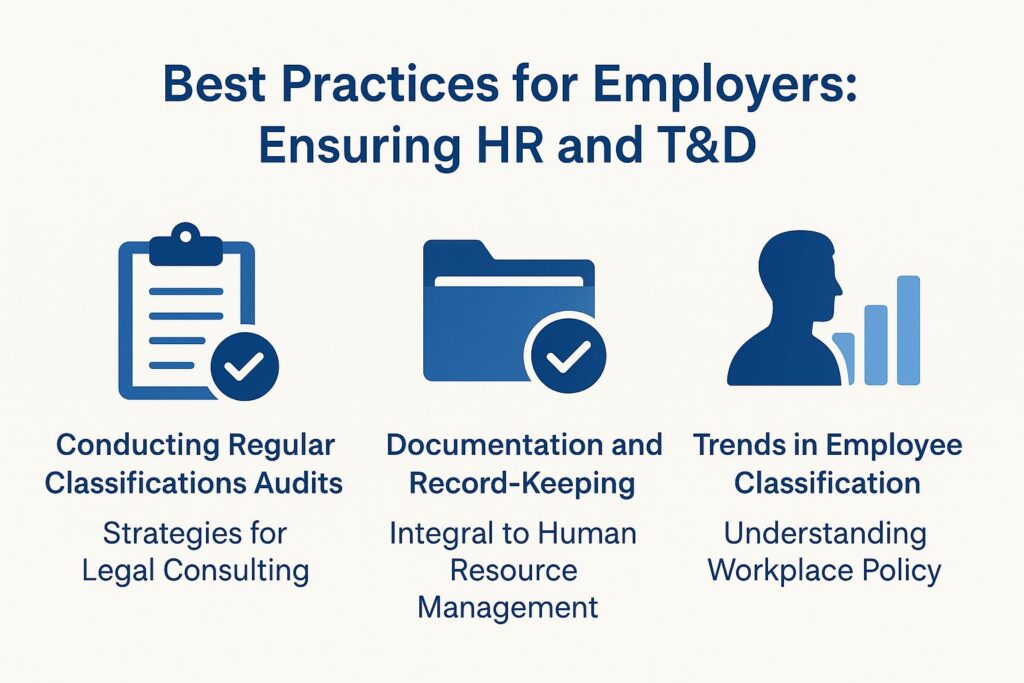
How to Perform Regular Classification Reviews: Tips for Legal Consulting
Regular classification audits help identify misclassifications, allowing businesses to correct issues proactively and avoid penalties that can exceed $100,000, ensuring regulatory compliance.
To carry out a successful classification audit, follow these steps:
- First, gather all relevant documents and data connected to product classifications, including job functions and employee contracts.
- Use compliance checklists, like those from the World Customs Organization, to cover all important topics and help with policy updates.
- Next, review your data by monitoring important numbers such as the rate of accurate classifications and cases of trade compliance issues, using performance measurements.
- Tools like Amber Road or TariffTel can help with identifying tariff categories and checking if they meet regulations, supporting workforce analytics.
- Schedule these audits quarterly to maintain accuracy and consistently keep penalties at bay, contributing to effective employee monitoring.
Documentation and Record-Keeping: Integral to Human Resource Management
Maintaining thorough documentation of employee classifications, including contracts and job descriptions, is essential for legal compliance and audit readiness, ensuring adherence to classification consulting.
To simplify your documentation process, use tools like BambooHR or Gusto for HR management. These tools help you maintain employee records and improve recruitment plans.
Keep contracts for at least seven years, ensuring data privacy. Review job descriptions each year to make sure they match current duties and correctly show the job titles.
Establish a centralized folder system-using cloud platforms like Google Drive or Dropbox-for quick access to documents, and schedule biannual audits to verify that your records are complete and up-to-date, supporting employee engagement.
This helps you follow the rules and manage your employees well, contributing to effective human resources management.
Trends in Employee Classification: A Look at Workplace Policy
Recent trends indicate a shift towards more stringent classification laws, especially concerning gig economy workers and remote work classifications, impacting HR practices and employer responsibilities.
One significant change is the implementation of the ABC test, which many states now adopt to determine if a worker is an independent contractor or an employee. According to the National Employment Law Project, approximately 25% of gig workers could be classified as employees under this test, affecting job market projections and employee demographics.
HR departments need to change by reviewing their methods for hiring and their rules for compliance, incorporating virtual work classification. Using tools like Gusto for handling payroll can help make sure you follow these new laws automatically. Regular training sessions on classification rules will keep staff updated and following the rules, aiding in skills assessment and change management.
About the Author
Kim Anderson is a Harvard University graduate with a bachelor’s degree in Accounting and Finance. She’s the owner of a successful payroll outsourcing firm based in California and a contributing writer for My Payroll Outsourcing. With 14 years of experience, Kim helps businesses streamline compliance, minimize administrative risk, and manage multi-state workforces with confidence.
